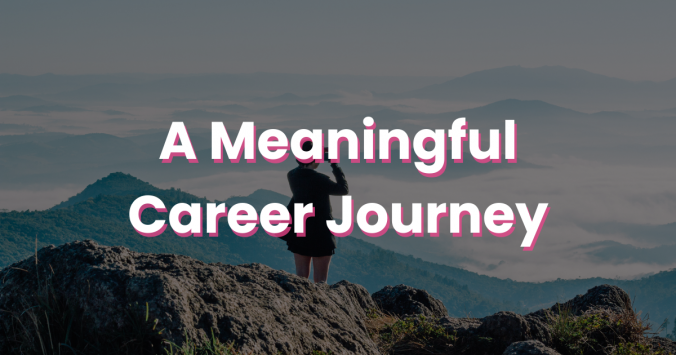Employers and Career Educators, I ask you, what does being on a meaningful career journey look like to you?
From my perspective, you are on a meaningful career journey if you approach your work with enthusiasm, are able to use your strengths to make a positive impact, and are financially independent.
This is something many of us wish for. In fact, a recent worldwide study conducted by Ipsos found that out of almost 20,000 adults surveyed, 48% indicated that one of the greatest sources of their happiness was “feeling that my life has meaning”.
Research conducted by the Brainstorm Strategy Group with 16,000 post-secondary students indicated that after “balancing work-life with personal life” students stated that their most important career goal is to “feel that I am serving a cause or greater good”.
In my recently published book, “Backpack to Briefcase, A Student’s Guide to a Meaningful Career Journey”, I provide readers with the steps and activities to guide them to launch their meaningful career. The book is divided into three phases, Discover, Build and Launch.
The ikigai
I begin by introducing readers to the ikigai framework. Ikigai is a Japanese word that roughly means “your reason for being”. You can identify your ikigai by discovering the answers to 4 questions posed in the circles in the diagram shown here. Your ikigai is found where the four circles intersect.
The ikigai circles capture:
- Circle 1: What You Love
- Circle 2: What You Are Good At
- Circle 3: What the World Needs
- Circle 4: What You Can be Paid For
Is there a role for Employers and Career Educators to guide students to discover their ikigai?
I believe so.
Here are some suggestions for guiding students to discover their ikigai. And I am sure you will recognize that you are already doing so!
What Can Employers Do?
- Circle 1: What You Love: When meeting students, employers can ask students to identify their passions, interests and hobbies, either in casual conversation or to break the ice.
- Circle 2: What You Are Good At: In interviews, to help students recognize their strengths or what they are good at, employers may ask students to share a task that they completed that they were proud of. Following up with a question to ask them to reflect on which of their strengths they used to accomplish this task, will tease out their natural talents.
- Circle 3: What the World Needs: When you are attending Career Fairs or networking events, share with candidates your company’s goals, values, and mission. This allows students to evaluate how their values align with your organization’s.
- Circle 4: What You Can be Paid For: As industry experts, share your knowledge about the state of your industry, the salary ranges, and the skills that are required for future roles. This provides young people with a sense of “where the puck is going” so they can acquire the skills employers are seeking.
What Can Career Educators Do?
- Circle 1: What You Love: Educators can continue to encourage students to step out of their comfort zone by joining clubs, taking different courses, or developing new passions.
- Circle 2: What You Are Good At: Instructors can promote completing the Gallup CliftonStrengths® or the Myers-Briggs® assessment, offered through the Career Center. This will provide students a way to identify and articulate their strengths and unique traits.
- Circle 3: What the World Needs: Have conversations with students about world issues. This will help students to consider which challenges or issues they are passionate about solving. In addition, showing student the ways to identify organizations that are already working on these challenges allows them to see that they can align their energies with others.
- Circle 4: What You Can be Paid For: Offer workshops or webinars outlining how to tap into Labour Market Information such as industry forecasts, salary ranges, attrition rates and the skills that are forecasted to be in demand. This information helps students narrow down their options.
In summary, these and many other ways allow you to prompt, guide and assist students as they discover their own sense of what is meaningful to them. This can lead them to a life with purpose, where they know that they are making a positive impact on the world, and feel energized on their journey as they pivot from role to role in response to growing and learning about themselves.
A life well-lived is more than fleeting moments of happiness; it also has meaning and purpose.

Stephanie and her PeerSpectives Consulting Co-Founder, Louann McCurdy are available to partner with Employers and Educators to collaborate on program development, guest speak, and facilitate workshops. Contact Stephanie at SK.Peerspectives@gmail.com
Interested in getting your own copy of the Backpack to Briefcase book?
You can purchase it here 






